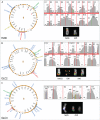Genomic organization and evolution of double minutes/homogeneously staining regions with MYC amplification in human cancer
- PMID: 25034695
- PMCID: PMC4132716
- DOI: 10.1093/nar/gku590
Genomic organization and evolution of double minutes/homogeneously staining regions with MYC amplification in human cancer
Abstract
The mechanism for generating double minutes chromosomes (dmin) and homogeneously staining regions (hsr) in cancer is still poorly understood. Through an integrated approach combining next-generation sequencing, single nucleotide polymorphism array, fluorescent in situ hybridization and polymerase chain reaction-based techniques, we inferred the fine structure of MYC-containing dmin/hsr amplicons harboring sequences from several different chromosomes in seven tumor cell lines, and characterized an unprecedented number of hsr insertion sites. Local chromosome shattering involving a single-step catastrophic event (chromothripsis) was recently proposed to explain clustered chromosomal rearrangements and genomic amplifications in cancer. Our bioinformatics analyses based on the listed criteria to define chromothripsis led us to exclude it as the driving force underlying amplicon genesis in our samples. Instead, the finding of coexisting heterogeneous amplicons, differing in their complexity and chromosome content, in cell lines derived from the same tumor indicated the occurrence of a multi-step evolutionary process in the genesis of dmin/hsr. Our integrated approach allowed us to gather a complete view of the complex chromosome rearrangements occurring within MYC amplicons, suggesting that more than one model may be invoked to explain the origin of dmin/hsr in cancer. Finally, we identified PVT1 as a target of fusion events, confirming its role as breakpoint hotspot in MYC amplification.
© The Author(s) 2014. Published by Oxford University Press on behalf of Nucleic Acids Research.
Figures






References
-
- Mitelman F., Johansson B., Mertens F. 2014. Mitelman Database of Chromosome Aberrations and Gene Fusions in Cancer. http://cgap.nci.nih.gov/Chromosomes/Mitelman.
-
- Vukovic B., Beheshti B., Park P., Lim G., Bayani J., Zielenska M., Squire J.A. Correlating breakage-fusion-bridge events with the overall chromosomal instability and in vitro karyotype evolution in prostate cancer. Cytogenet. Genome Res. 2007;116:1–11. - PubMed
-
- Storlazzi C.T., Fioretos T., Surace C., Lonoce A., Mastrorilli A., Strombeck B., D'Addabbo P., Iacovelli F., Minervini C., Aventin A., et al. MYC-containing double minutes in hematologic malignancies: evidence in favor of the episome model and exclusion of MYC as the target gene. Hum. Mol. Genet. 2006;15:933–942. - PubMed
Publication types
MeSH terms
Grants and funding
LinkOut - more resources
Full Text Sources
Other Literature Sources

